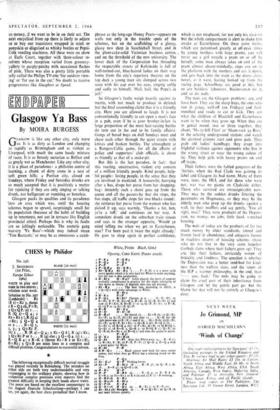CHESS by Philidor
No. 298.
J. SAVODRNIN (1st Prize, Europe Echecs 1964) mum to play and
mate in two moves ; solution next week. Solution to No. 29'7 (Loshinski) : Kt (B x) — Kt 3, threat zit —Qach,PxR; 3 QXQP.(a)
BLACK (I0 men) R (Q Q 4; 2 Kt—Kt 5 R (Q 4) X Kt ; 3 Q— Q 4 01' 2 . . 2, 3; 3 Q x Kt P. (b) . . ,R (R 4)—Q 4; 2 Kt — Q 6!, R (4) x Kt ; 3 Qx P or 2 . R (4) else ;_3 Q — Q 4. (c) R—Q B 4; z R —K 2 (threat Kt — B 2 or Kt x R), B x ; 3 Q x B are main lines in a complex and difficult problem. Congratulations to successful solvers.
The following exceptionally difficult tactical struggle was played recently in Rabenberg. The mistakes on Eicher side are both very understandable and Very enaiiraging to the-ordinary pla3iir, showing how in unfamiliar complex positions even masters find the greatest difficulty itt.g their heads above water. . The notes are based on the excellent commentary in the August Deutsche Sdtachzeituttg—perhips-I can say, yet again, the best chess periodical that I know. WHITE (it men) White,Fuois Black, Gotz Opening, CARO KANN (Panov attack) r P - K 4 P - Q B 3 2 P - Q P - Q 4 3 PxP PxP
P-QB4 Kt-KB3
5 Kt - Q B 3 Kt -Bs 5 . P-K Kt 3 is a more solid move against which it is very hard for White to make anything, but the text is also satisfactory. 6 B - Kt 5 Q- R4!? Little played, the merit of surprise probably compensates in practice for the slight inferiority of this move in theory: it depends .who you are playing! 7 Kt- H3 . .. The best line, according to MCO, is 7 Q--Q 2 With some advantage to White.
B- Kt 5 8B-Ka PxP
PP-QS Bx Kt? Correct is 9. . . 0-0-0!; 10 B x Kt, K P xB; Kt—Q 2, B x B; 52 Q x B, B—Kt 5! and now 13 P x Kt?, K R—K z ! or 14 Q x p, B x Kt; z5 P x B, Qx2P or z4 KtxP,QxP. ro B x
ii 0 - 0 0 - 0 - 0
12 R- Br? . . . He feared 12 . Kt x B ch; Q x Kt,
Kt xP; i. Q x P, Kt x Kt and then r . 5_, . Q x B, but the
right move was 12 RXKI1 and if 12 . Kt x11 ch; 13 Q x Kt, Kt xP; z4 Q X P, Kt x Kt; 15 Q—K ch!, R—Q 2 OS 1 • • K—Kt z; z6 B—B 4 oh); 16 P x Kt, Q xR; 17 _ Q—Kt 5; itt R—K 5, Q—B 3; x9 R—tien 5! QxR; 20 Q x R ds, K—Kt z • az R—Q 5! and wins queen or mates. 12 P- kg! 13Q-Kz Ktx8 ch 24 Q x Kt PxP? After this White win' ta . B - K 2 l; IS BxKt, B xB; t6 PxP, PxP; 57 Q—K 4, K—Q 4 with a good game for Black.
15B x Kg P x B " • KR-Qz . .* Black cannot now hold the extra centre pawns, and when they go White has a winning attack on the hng. • . P - Q 5 17 Kt - K Q x P Nothing better. 28 Kt xP - 1Ct 5 a . B -R 3?; 19 Q-R 3 ch. 18 B—B 4?; 19 Q—B 5 ch. za R - R Q xP - • so P 8-86 20 . . . R -Q 2 21 R -R S eh, K—B 2; 22 Kt—Kt 5 or K 6 ch and 23 R (I) x R winning. 21 R-R8ch K-82 asQ -B 4ch • 1:,-K$3 • . • QxPchK-114 • 24 V-K7 ch. R-413 . . . K - Kt 3; 25 R R, etc. 25 t- Kg 3 chi Resigns as *.•'; P or QxKr; 26 QxR els and mate follows quickly.






























 Previous page
Previous page